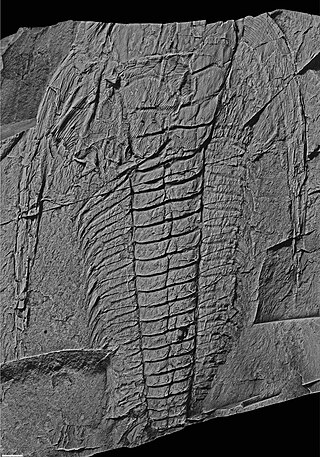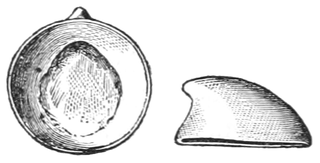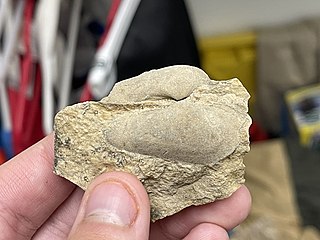
John William Salter was an English naturalist, geologist, and palaeontologist.

The Bellerophontidae are an extinct family of specialized globose bellerophontids, Paleozoic and early Triassic mollusks of the class Gastropoda.
Cameroceras is an extinct genus of endocerid cephalopod which lived in equatorial oceans during the entire Ordovician period. Like other endocerids, it was an orthocone, meaning that its shell was fairly straight and pointed. It was particularly abundant and widespread in the Late Ordovician, inhabiting the shallow tropical seas in and around Laurentia, Baltica and Siberia.

Nanno is an extinct genus of endocerid, named by Clarke in 1894 for the apical end of an endocerid from the Trenton Limestone of New York state that has the basic description of the nanno type. It is possibly a senior synonym for Proterovaginoceras. As a valid genus, Nanno is included in the Endoceratidae, but the nanno type apex may be found in other families.

Pomatiopsidae is a family of small, mainly freshwater snails, that have gills and an operculum, aquatic gastropod mollusks in the superfamily Truncatelloidea.

Bellerophontoidea, common name "bellerophonts", is a superfamily of extinct planospirally-coiled globose molluscs. This superfamily is generally included within the Gastropoda, but may instead be a group of monoplacophorans. The taxon first appeared late in the Cambrian and continued until late in the Triassic.

Coreospiridae is an extinct family of Paleozoic molluscs of uncertain position taxonomically. They might be snails (Gastropoda), Helcionelloida, or they might be Monoplacophora.

†Archinacellidae is an extinct family of paleozoic molluscs of uncertain position.
Bucaniidae is an extinct family of Paleozoic molluscs of uncertain position possibly being either gastropods or monoplacophorans in the superfamily Bellerophontoidea. The family lived from the Lower Ordovician to the Devonian and have shells in which the apertural margins tend to flare. Most genera have a slit and selenizone, others some modification of this feature.
Sinuitidae is an extinct family of Paleozoic molluscs of uncertain position. They had isostrophically coiled shells.

Craspedostomatidae is an extinct taxonomic family of fossil sea snails, marine, gastropod mollusks in the subclass Gastropoda incertae sedis, unassigned in the class Gastropoda.

Pilina unguis is an extinct species of Paleozoic Silurian monoplacophoran. It was first named as Tryblidium unguis and described by Gustaf Lindström in Latin from the Silurian deposits of Gotland in Sweden, in 1880.

Pilina is an extinct genus of paleozoic monoplacophorans in the family Tryblidiidae.

Tryblidiidae is an extinct family of paleozoic monoplacophorans in the superfamily Tryblidioidea.

Helcionopsis radiatum is an extinct species of paleozoic monoplacophoran in the family Tryblidiidae.

Helcionopsis striata is an extinct species of paleozoic monoplacophoran in the family Tryblidiidae.
Helcionopsis subcarinata is an extinct species of paleozoic monoplacophoran in the family Tryblidiidae.

Similodonta is an extinct genus of early bivalve in the extinct family Praenuculidae. The genus is one of eleven genera in the subfamily Praenuculinae. Similodonta is known from Middle Ordovician through Middle Silurian fossils found in Europe and North America. The genus currently contains eight accepted species, Similodonta ceryx, Similodonta collina, Similodonta djupvikensis, Similodonta magna, Similodonta recurva, Similodonta spjeldnaesi, Similodonta wahli and the type species Similodonta similis.
The Pitkin Formation, or Pitkin Limestone, is a fossiliferous geologic formation in northern Arkansas that dates to the Chesterian Series of the late Mississippian. This formation was first named the "Archimedes Limestone" by David Dale Owen in 1858, but was replaced in 1904. The Pitkin conformably overlies the Fayetteville Shale and unconformably underlies the Pennsylvanian-age Hale Formation. Some workers have considered the shales at the top of the Pitkin Formation to be a separate formation called the Imo Formation. More recently, others have considered the Imo to be informal member of the Pitkin Formation.
Phragmolites is an extinct genus of molluscs in the family Bucaniidae, paleozoic molluscs of uncertain position possibly being either Gastropods or Monoplacophorans in the superfamily Bellerophontoidea.











